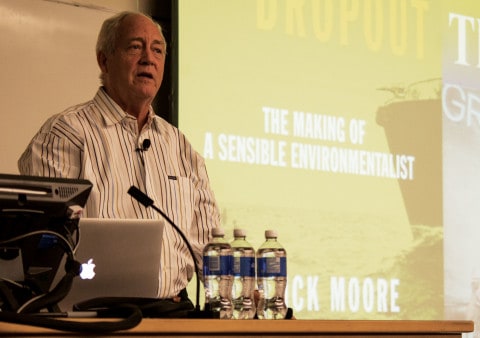October is Agriculture month in Saskatchewan and the College of Agriculture and Bioresources took this opportunity to welcome Patrick Moore, former Greenpeace activist turned biotechnology backer, to speak on the misconceptions that Moore claims Greenpeace perpetuates.
On Oct. 8, Moore spoke to a crowded Neatby-Timlin Theatre at the University of Saskatchewan. Included in his presentation were photos of his notorious involvement in high-stakes Greenpeace-led initiatives, including confronting boats on the North Pacific that were conducting United States hydrogen bomb testing in Alaska. Moore followed this up with several research-based slides disputing claims that global warming and climate change have any definite correlation to human life and activity on Earth.
Shayla Hertz, U of S Agriculture Students’ Association president and fourth-year agribusiness student was the emcee for the evening. Growing up on a grain farm outside of Edenwold, Sask., Hertz shared her perspective on environmentalism and the importance of science and agriculture.
“It was not until I started encountering people telling me that organic food was healthier than conventionally farmed foods and that genetically modified organisms were dangerous that I knew what I cared deeply about, and that is setting out on a path to correct the misconceptions surrounding agriculture and agrifood sectors,” Hertz said.
Students in the College of Agriculture and Bioresources now account for approximately seven per cent of total enrollment at the U of S, an 11.5 per cent increase over the last year alone, which makes it  the fastest growing college at the university. As such, the issue of misconceptions within the agriculture industry is especially prevalent.
the fastest growing college at the university. As such, the issue of misconceptions within the agriculture industry is especially prevalent.
Hertz set the stage for Moore by acknowledging that today’s society is connected more than ever before and that as quickly as people may be informed, they are just as vulnerable to misinformation.
“Despite the fact that there are farmers, scientists, doctors, researchers, professors, government officials and individuals working around the clock to create the safest, healthiest and most environmentally conscious agriculture supply system possible, there are people who would believe otherwise and for some reason, those voices are the ones who are heard,” Hertz said.
Moore began his presentation by providing some insight into his upbringing and what lead him to the concept of Greenpeace.
“I was doing my PhD in ecology in the mid 60s, at the height of the Vietnam war and the height of the Cold War, and the threat of all-out nuclear war and a newly converging consciousness of the environment. I turned into a radical environmental activist as a result,” Moore said.
After 15 years of active involvement in the rapidly growing organization, Moore realized that his personal views no longer aligned with the vision of Greenpeace, as he saw it.
“When we began, we had a strong humanitarian orientation, to save civilization from all-out nuclear war. As we evolved, taking on other issues, the peace kind of got left behind and all that was left was the green, and now Greenpeace and much of the environmental movement characterized the human species as the enemy of the Earth,” Moore said.
The remaining 90 minutes of the presentation included an exploration of graphs and scientific research-based data provided by various industry leaders, which promoted the use of genetically modified organisms, the need for more carbon dioxide in the atmosphere, Moore’s belief in the reclamation of the oil sands tailings ponds and a comparison of people who are against these concepts to be much like the “anti-vaccine quacks.”
Despite some dissenting remarks and shaking of heads from the crowd, Moore went on to agree with Hertz’s opening remarks on the global population increasing at an exponential rate and that innovations in science and agricultural development are essential to the future of food production.
“It used to take 78 per cent of the world’s population to grow food for the 100 per cent; now it takes two or three per cent and one farmer in Saskatchewan feeds 155 people. That’s the power of science, technology, chemistry and genetics,” Moore said, adding that this frees up the remainder of society to focus on other significant developments and services.
Although, much of the information Moore provided in his presentation was sourced from leading industry experts, Hertz encourages students to always exercise their right to information.
“It is of utmost importance that people become aware of the falsities that they have been exposed to as a result of social media and popular belief. People need to begin to recognize the importance of questioning the information they are exposed to and understand how critical it is to conduct their own research,” Hertz said.
—
Photo: Michael Bergen